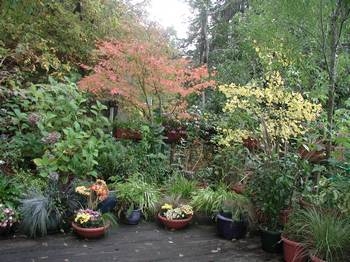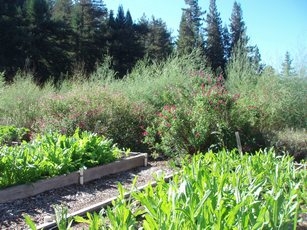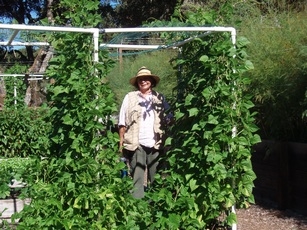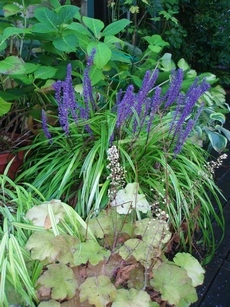The end of daylight savings time signals to me that autumn is really here in our mild California surroundings. We may not have as many fall color foliage trees and shrubs as other states but we love ours just as much. Besides we don’t get snow two days before Halloween. Can you imagine? Enjoy these crisp mornings and warm days and to make your garden more compelling, try mixing in trees and shrubs with bold leaves and a wide range of autumn color.

But what about vivid foliage in the garden? Which plants put on the best show in our area? Here are some of my favorites.
We are all familiar with the brilliant fall color of Japanese maples. Bloodgood is probably the single most popular upright purple-leaved variety seen in gardens. Beautiful in color and form, it’s easy to grow and fits nicely in the smaller garden.
A great tree for the gardener interested in edibles is the Fuyu persimmon. This beautiful small tree is ornamental with glossy green leaves and also offers a dramatic fall display in shades of yellow, orange and red. Bright orange fruit begins to develop in late October and clings to bare branches usually through December. The tree looks more like it’s covered with holiday ornaments than fruit. And have you priced persimmons in the store lately?
Blueberries are a must for the edible gardener. They can used to make a beautiful hedge that provides showy red or yellow fall color. Because of our colder winters here in the mountains, we can grow both northern highbush which are self-fertile and southern highbush which produce better with another type to pollinize them. They can be great foundation plants around the home as well as in the garden.
A vine that lights up with the onset of autumn is Rogers Red California grape. If you have an arbor, wall or fence that need covering quickly, this is your plant. The green and gray leaves are transformed in autumn into great draperies of rich, scarlet red leaves with clusters of summer fruit turning all shades of purple.
Japanese barberries are deer resistant, low water-use small shrubs that make them superb hedge plants, background plants against fences and foundations or accent plants. Red or lime colored summer foliage changes to orange, red or amber in the fall. I love the graceful growing habit of many of the varieties but there are pillar forms and also dwarf types.
Bright foliage on trees like red maples, liquidamber, Chinese pistache, ginkgo, ornamental pear, cherry or crabapple, dogwood, goldenrain, locust, katsura, oak, redbud, sumac and witchhazel all add to the fall drama of the landscape.
Light up your garden as the light fades and the days shorten. I know my garden needs a greater variety of fall color than just the Japanese maples in pots on the deck and the barberries. Maybe I’ll add a purple smoke bush with leaves than turn luminous scarlet to add color flashes to my fall garden.

 Linda Butler starts all her vegetables from seed, and grows year-round. Some are started directly in the beds while others are started in flats and transplanted later. Cole crops, such as broccoli, cauliflower and cabbage, would get eaten by bugs and birds would eat them as fast as they germinated so these are started in flats.
Linda Butler starts all her vegetables from seed, and grows year-round. Some are started directly in the beds while others are started in flats and transplanted later. Cole crops, such as broccoli, cauliflower and cabbage, would get eaten by bugs and birds would eat them as fast as they germinated so these are started in flats.  Steven, started the farm in 2007. Their 90 acres is zoned mixed agriculture but since some of it encompasses rare Ben Lomond sandhills habitat, they farm just a couple of acres. They have even installed a wide deer corridor separating the growing areas to allow the deer access to their feeding and watering places.Tall fences protect the beds from other critters but they encourage the birds and bees by planting flowers that seed, attract beneficial insects and produce pollen.
Steven, started the farm in 2007. Their 90 acres is zoned mixed agriculture but since some of it encompasses rare Ben Lomond sandhills habitat, they farm just a couple of acres. They have even installed a wide deer corridor separating the growing areas to allow the deer access to their feeding and watering places.Tall fences protect the beds from other critters but they encourage the birds and bees by planting flowers that seed, attract beneficial insects and produce pollen.  Don’t prune now, you’ll be happy to hear. Fall is not a good time to prune. Wounds heal slowly, leaving them more susceptible to disease. As a general rule, don’t prune when leaves are falling or forming. Wait to prune most trees until late in the dormant season or in late spring after leaves and needles form. To avoid sap flow on birches and maples, prune after leaves mature.
Don’t prune now, you’ll be happy to hear. Fall is not a good time to prune. Wounds heal slowly, leaving them more susceptible to disease. As a general rule, don’t prune when leaves are falling or forming. Wait to prune most trees until late in the dormant season or in late spring after leaves and needles form. To avoid sap flow on birches and maples, prune after leaves mature.  up when the first drops started to fall. Everything looks brighter and more vivid now. I can even get a shovel in the earth to turn over the soil in those dry spots where I’d love to plant a new tree or shrub. The soil is still warm and will nurture new root growth. It’s a good time to plant a new fruit tree, edible shrub like a blueberry or maybe even something with beautiful fall color.
up when the first drops started to fall. Everything looks brighter and more vivid now. I can even get a shovel in the earth to turn over the soil in those dry spots where I’d love to plant a new tree or shrub. The soil is still warm and will nurture new root growth. It’s a good time to plant a new fruit tree, edible shrub like a blueberry or maybe even something with beautiful fall color.
 wet winters. After Glow is frost tolerant and looks to be painted with florescent paint. There are spectacular hybrids being developed every year. These are not as hardy as the traditional hens and chicks but well worth the effort to find a place where they can survive a freeze. Frilly Mauna Loa sports turquoise and burgundy foliage while echeveria Blue Curls looks like an anemone in a tide pool.
wet winters. After Glow is frost tolerant and looks to be painted with florescent paint. There are spectacular hybrids being developed every year. These are not as hardy as the traditional hens and chicks but well worth the effort to find a place where they can survive a freeze. Frilly Mauna Loa sports turquoise and burgundy foliage while echeveria Blue Curls looks like an anemone in a tide pool.